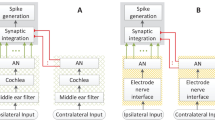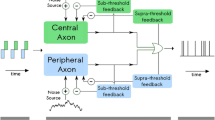Abstract
Cochlear nucleus neurons revealing ideal onset (OI)-type peri-stimulus time histograms (PSTH) encode temporal features of acoustic stimuli with very high precision. These neurons are therefore assumed to be involved in the recognition of natural sounds with temporally varying envelopes such as speech. A functional point-neuron model is presented here for the simulation of OI-unit responses found in cochlear nucleus octopus cells. The model assumes a biphasic response of the membrane potential to a current impulse, the membrane impulse response, and a dynamic spike-blocking mechanism. The predicted responses to pure tones at low and high frequencies, injected current steps, and amplitude modulated tones are compared to recordings from the literature. The model accounts for the main response properties in the data using the same small set of parameters for all experimental conditions. The assumed biphasic shape of the membrane impulse response, reflecting a higher sensitivity to stimulus transients and fast changes relative to sustained stimulus portions, allows for a description of OI-unit responses that cannot be accounted for by a coincidence detector model with an integrate-to-threshold dynamic. The presented functional model may be useful as a processing module in more complex models of auditory signal processing and perception.
Similar content being viewed by others
References
Bal R, Oertel D (2001) Potassium currents in octopus cells of the mammalian cochlear nucleus. J. Neurophysiol. 86: 2299–2311.
Bregman AS (1990) Auditory Scene Analysis: The Perceptual Organization of Sound. MIT Press, Cambridge.
Cai Y, Walsh EJ, McGee J (1997) Mechanisms of onset responses in octopus cells of the cochlear nucleus: Implications of a model. J. Neurophysiol. 78: 872–883.
Cai Y, McGee J, Walsh EJ (2000) Contributions of ion conductances to the onset responses of octopus cells in the ventral cochlear nucleus: Simulation results. J. Neurophysiol. 83: 301–314.
Cai Y, McGee J, Walsh EJ (2001) Processing of pitch information in complex stimuli by a model of octopus cells in the cochlear nucleus. In: S Greenberg, M Slaney, eds., Computational Models of Auditory Function. IOS Press, Amsterdam.
Ferragamo MJ, Oertel, D (2002) Octopus cells of the mammalian ventral cochlear nucleus sense the rate of depolarization. J. Neurophysiol. 87: 2262–2270.
Frisina RD, Smith RL, Chamberlain SC (1990) Encoding of amplitude modulation in the gerbil cochlear nucleus: I. A hierarchy of enhancement. Hear. Res. 44: 99–122.
Gardner SM, Trussell LO, Oertel D (1999) Time course and permeation of synaptic AMPA receptors in cochlear nucleus neurons correlate with input. J. Neurosci. 19: 8721–8729.
Godfrey DA, Kiang NYS, Norris BE (1975) Single unit activity in the posteroventral cochlear nucleus of the cat. J. Comp. Neurol. 162: 247–268.
Goldberg JM, Brown PB (1969) Responses of binaural neurons of dog superior olivary complex to dichotic stimuli: Some physiological mechanisms of sound localization. J. Neurophysiol. 32: 613–636.
Golding NL, Robertson D, Oertel D (1995) Recordings from slices indicate that octopus cells of the cochlear nucleus detect coincident firing of auditory nerve fibers with temporal precision. J. Neurosci. 15: 3138–3153.
Golding NL, Ferragamo MJ, Oertel D (1999) Role of intrinsic conductances underlying responses to transients in octopus cells of the cochlear nucleus. J. Neurosci. 19: 2897–2905.
Kalluri S, Delgutte B (2003a) Mathematical models of cochlear nucleus onset neurons: I. Point neuron with many weak synaptic inputs. J. Comp. Neurosci. 14: 71–90.
Kalluri S, Delgutte B (2003b) Mathematical models of cochlear nucleus onset neurons: II. Model with dynamic spike-blocking state. J. Comp. Neurosci. 14: 91–110.
Kane EC (1973) Octopus cells in the cochlear nuclei of the cat: Heterotypic synapses upon homeotypic neurons. Int. J. Neurosci. 5: 251–279.
Kipke DR, Levy KL (1997) Sensitivity of the cochlear nucleus octopus cell to synaptic and membrane properties. J. Acoust. Soc. Am. 102: 403–412.
Levy KL, Kipke DR (1997) A computational model of the cochlear nucleus octopus cell. J. Acoust. Soc. Am. 102: 391–402.
Levy KL, Kipke DR (1998) Mechanisms of the cochlear nucleus octopus cell’s onset response: Synaptic effectiveness and threshold. J. Accoust. Soc. Am. 103: 1940–1950.
Liberman MC (1993) Central projections of auditory nerve fibers of differing spontaneous rate. II: Posteroventral and dorsal cochlear nuclei. J. Comp. Neurol. 327: 17–36.
Meddis R, Hewitt MJ, Shackleton TM (1990) Implementation details of a computation model of the inner hair-cell/auditory-nerve synapse. J. Acoust. Soc. Am. 87: 1813–1816.
Meddis R (1986) Simulation of mechanical to neural transduction in the auditory receptor. J. Acoust. Soc. Am. 79: 702–711.
Meddis R (1988) Simulation of auditory-neural transduction: Further studies. J. Acoust. Soc. Am. 83: 1056–1063.
Oertel D, Bal R, Gardner SM, Smith PH, Joris PX (2000) Detection of synchrony in the activity of auditory nerve fibers by octopus cells of the mammalian cochlear nucleus. PNAS. National Academy of Sciences Colloquium on Auditory Neuroscience: Development, Transduction and Integration .
Patterson RD, Nimmo-Smith I, Holdsworth J, Rice P (1988) An efficient auditory filterbank based on the gammatone function. APU report 2341, Applied Psychology Unit, Cambridge.
Rhode WS, Smith PH (1986) Encoding timing and intensity in the ventral cochlear nucleus of the cat. J. Neurophysiol. 56: 261– 286.
Rhode WS (1994) Temporal coding of 200% amplitude modulated signals in the ventral cochlear nucleus of cat. Hear. Res. 77: 43–68.
Romand R (1978) Survey of intracellular recording in the cochlear nucleus of the cat. Brain Res. 148: 43–65.
Smith PH, Rhode WS (1989) Structural and functional properties distinguish two types of multipolar cells in the ventral cochlear nucleus. J. Comp. Neurol. 282: 595–616.
Stevens KN (1995) Applying phonetic knowledge to lexical access. In: Fourth European Conference on Speech Communication and Technology, Vol. 1. Madrid, Spain.
Tuckwell HC (1988) Introduction to Theoretical Neurobiology, Vol. 1. Cambridge University Press, Cambridge, England.
Winter IM, Palmer AR (1995) Level dependence of cochlear nucleus onset unit responses and facilitation by second tones or broadband noise. J. Neurophysiol. 73: 141–159.
Young E, Robert JM, Shofner W (1988) Regularity and latency of units in ventral cochlear nucleus: Implications for unit classification and generation of response properties. J. Neurophysiol. 60: 1–29.
Author information
Authors and Affiliations
Corresponding author
Rights and permissions
About this article
Cite this article
Dicke, U., Dau, T. A Functional Point-Neuron Model Simulating Cochlear Nucleus Ideal Onset Responses. J Comput Neurosci 19, 239–253 (2005). https://doi.org/10.1007/s10827-005-1847-0
Received:
Revised:
Accepted:
Issue Date:
DOI: https://doi.org/10.1007/s10827-005-1847-0




